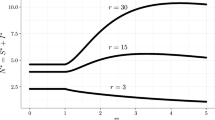Abstract
We extend classic discrete-time susceptible-infective-susceptible (SIS) and susceptible-exposed-infectious-susceptible epidemic models to include disease transmission dynamics in exploited fish populations that exhibit compensatory (contest competition) and overcompensatory (scramble competition) stock dynamics with and without the strong Allee effect. We compute the basic reproductive number, \({\mathfrak{R}_{0}}\), and use it to predict the (uniform) persistence or extinction of the infective exploited fish population, where the fish stock dynamics are compensatory and the strong Allee mechanism is either present or absent. We use the SIS epidemic model to explore the relationship between the stock demographic equation and the epidemic process, where the total stock population dynamics are overcompensatory. As in “higher” human and animal populations, we show that the demographic exploited fish population dynamics drive both the susceptible and infective stock dynamics.
Similar content being viewed by others
References
Allen L., Burgin A.M.: Comparison of deterministic and stochastic SIS and SIR models in discrete-time. Math. Biosci. 163, 1 (2000)
Allen L.: Some discrete-time SI, SIR and SIS models. Math. Biosci. 124, 83 (1994)
Allen L., van den Driessche P.: The basic reproduction number is some discrete-time epidemic models. J. Diff. Eqns. Appl. 14(10–11), 1127–1147 (2008)
Anderson R.M., May R.M.: Infectious diseases of humans: dynamics and control. Oxford University, Oxford (1992)
Arreola, R., Crossa, A., Velasco, M.C.: Discrete-time S-E-I-S models with dispersal between two patches, Biometric Department, MTBI Cornell University Technical Report (2000)
Bailey N.T.J.: The simple stochastic epidemic: a complete solution in terms of known functions. Biometrika. 50, 235 (1963)
Begon M., Harper J.L., Townsend C.R.: Ecology: Individuals, Populations And Communities. Blackwell, Oxford (1996)
Best J., Castillo-Chavez C., Yakubu A.-A.: Hierarchical competition in discrete time models with dispersal. Fields Inst. Commun. 36, 59–86 (2003)
Beverton, R.J.H., Holt, S.J.: On the dynamics of exploited fish populations, H. M. Stationery Off., London, Fish. Invest., 2, 19, (1957)
Castillo-Chavez C., Yakubu A.: Dispersal, disease and life-history evolution. Math. Biosci. 173, 35–53 (2001)
Castillo-Chavez C., Yakubu A.: Epidemics on attractors. Contemp. Math. 284, 23–42 (2001)
Castillo-Chavez C., Yakubu A.: Discrete-time S-I-S models with complex dynamics. Nonlinear Anal. TMA 47(7), 4753–4762 (2001)
Castillo-Chavez, C., Yakubu, A.A.: Intraspecific competition, dispersal and disease dynamics in discrete-time patchy environments. In: Castillo-Chavez, C., Blower, S., van den Driessche, P., Denise, K., Abdul-Aziz, Y. (Eds.) Mathematical Approaches For Emerging and Reemerging Infectious Diseases: An Introduction to Models, Methods and Theory, Springer, New York (2002)
Caswell, H.: Matrix Population Models: Construction, Analysis and Interpretation, Sinauer Associates Inc, Sunderland (2001)
Cooke K.L., Yorke J.A.: Some equations modelling growth processes of gonorrhea epidemics. Math. Biosci. 16, 75 (1973)
Cull P.: Local and global stability for population models. Biol. Cybern. 54, 141 (1986)
Elaydi S.N.: Discrete Chaos. Chapman & Hall/CRC, Boca Raton (2000)
Elaydi S.N., Yakubu A.-A.: Global stability of cycles: Lotka–Volterra competition model with stocking. J. Differ. Equ. Appl. 8(6), 537–549 (2002)
Ewald P.W.: Evolution of infectious disease. Oxford University, Oxford (1994)
Franke J.E., Yakubu A.-A.: Discrete-time SIS epidemic model in a seasonal environment. SIAM J. Appl. Math. 66(5), 1563–1587 (2006)
Franke J.E., Yakubu A.-A.: Disease-induced mortality in density-dependent discrete-time SIS epidemic models. J. Math. Biol. 57, 755–790 (2008)
Hadeler K.P., van den Driessche P.: Backward bifurcation in epidemic control. Math. Biosci. 146, 15 (1997)
Hassell, M.P.: The Dynamics of Competition and Predation. Studies in Biology, vol. 72, The Camelot Press Ltd., Southampton (1976)
Hassell M.P., Lawton J.H., May R.M.: Patterns of dynamical behavior in single species populations. J. Anim. Ecol. 45, 471–486 (1976)
Kocic, V.L., Ladas, G.: Global behavior of nonlinear difference equations of higher order with applications. Mathematics and its Applications, vol. 256, Kluwer Academic Publishers Group, Dordrecht (1993)
Kulenovic M.S., Yakubu A.-A.: Compensatory versus overcompensatory dynamics in density-dependent Leslie models. J. Differ. Equ. Appl. 10(13–15), 1251–1265 (2004)
May R.M., Oster G.F.: Bifurcations and dynamic complexity in simple ecological models. Am. Nat. 110, 573–579 (1976)
May R.M.: Simple mathematical models with very complicated dynamics. Nature 261, 459–469 (1977)
May R.M.: Stability and Complexity in Model Ecosystems. Princeton University Press, Princeton (1974)
McClusky C.C., Muldowney J.C.: Bendixson–Dulac criteria for difference equations. J. Dyn. Differ. Equ. 10, 567 (1998)
Nicholson A.J.: Compensatory reactions of populations to stresses, and their evolutionary significance. Aust. J. Zool. 2, 1–65 (1954)
Rios-Soto, K.R., Castillo-Chavez, C., Neubert, M.G., Titi, E.S., Yakubu, A.: Epidemic spread in populations at demographic equilibrium, Contemporary Mathematics, AMS, Mathematical Studies on Human Disease Dynamic: Emerging Paradigms and Challenges, vol. 410, pp. 297–309 (2006)
van den Driessche P., Watmough J.: A simple SIS epidemic model with a backward bifurcation. J. Math. Biol. 40, 525 (2000)
Reno P.W.: Factors involved in the dissemination of disease in fish populations. J. Aquat. Animal Health 10, 160–171 (1998)
Yakubu A.-A.: Allee effects in a discrete-time SIS epidemic model with infected newborns. J. Differ. Equ. Appl. 13(4), 341–356 (2007)
Yakubu A.-A.: Discrete-time metapopulation dynamics and unidirectional dispersal. J. Differ. Equ. Appl. 9(7), 633–653 (2003)
Yakubu, A.-A.: Introduction to discrete-time epidemic model, DIMACS Series in Discrete Mathematics and Thoeretical Computer Science (in press)
Yakubu A.-A., Fogarty M.: Spatially discrete metapopulation models with directional dispersal. Math. Biosci. 204, 68–101 (2006)
Yodzis P.: Introduction to Theoretical Ecology. Harper and Row Publishers, New York (1989)
Zhao X.-Q.: Asymptotic behavior for asymptotically periodic semiflows with applications. Comm. Appl. Nonlinear Anal. 3, 43–66 (1996)
Author information
Authors and Affiliations
Corresponding author
Rights and permissions
About this article
Cite this article
Yakubu, AA., Ziyadi, N. Discrete-time exploited fish epidemic models. Afr. Mat. 22, 177–199 (2011). https://doi.org/10.1007/s13370-011-0016-z
Received:
Accepted:
Published:
Issue Date:
DOI: https://doi.org/10.1007/s13370-011-0016-z




